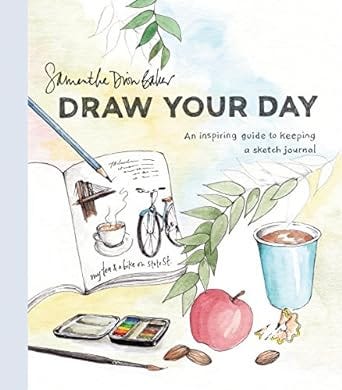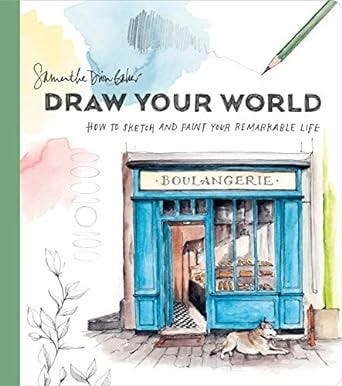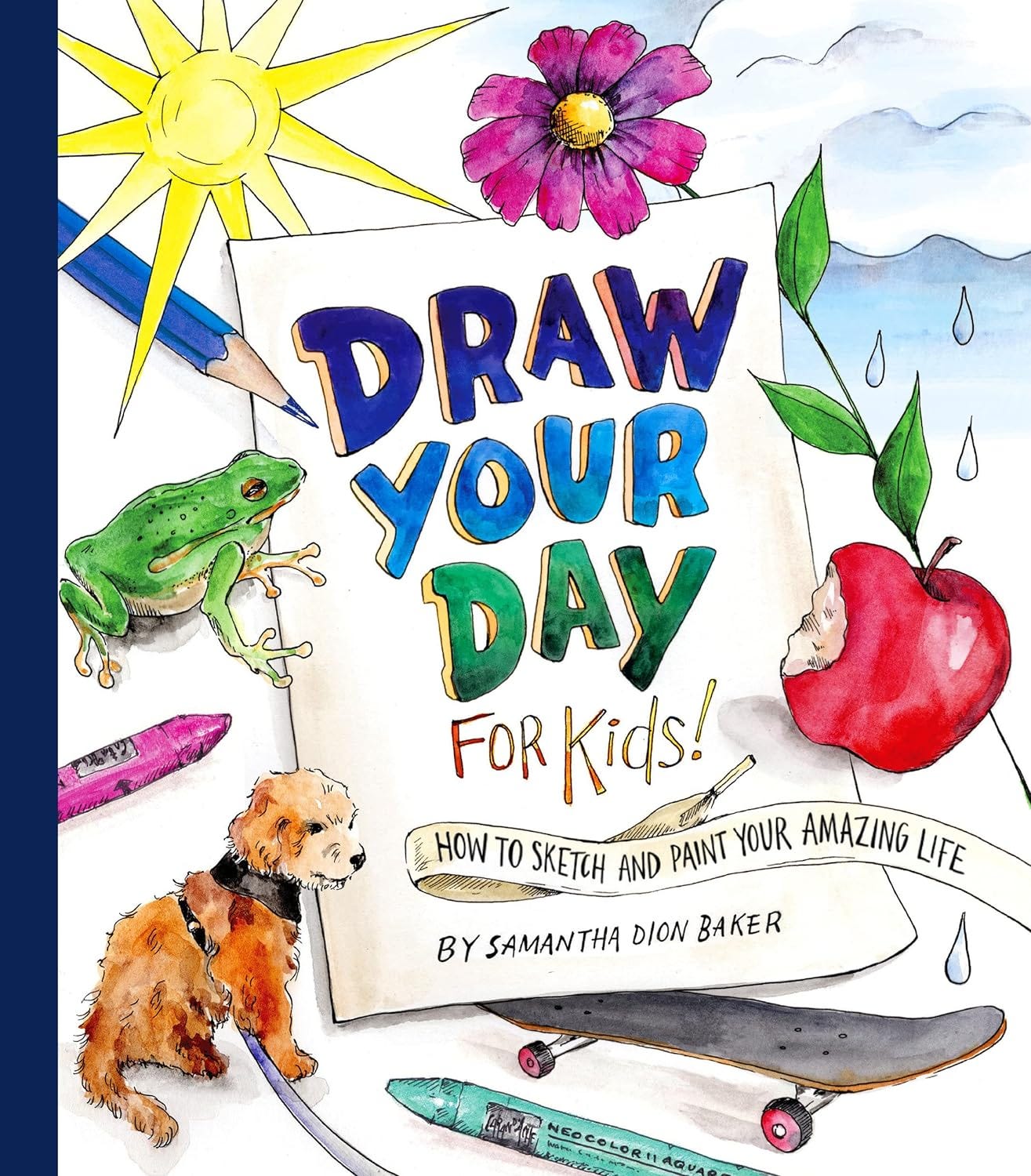Draw Your Day for Kids
Samantha Dion Baker's book to inspire kids (and adults) to keep an illustrated journal

I am a big fan of Samantha Dion Baker, an illustrator who creates beautiful illustrated journals.
I mentioned a week or so ago that I had wanted to highlight this book. It got away from me once before when I planned to talk about it on the podcast. So that it doesn’t get away from me again, I’m going to post this separately. All of Samantha’s books are books on illustrated journaling that I think you will enjoy looking at, but I want to give you an inside look today at the book specifically geared to younger artists.
Draw Your Day for Kids
I did a show on Draw Your Day a few years back, Episode 352. I love Samantha's work. I'm not sure I believe people walk away from Draw Your Day thinking, “hey, I really can keep an illustrated journal like that.” But anyone looking at the book is sure to be inspired. Her spreads are gorgeously composed. She does beautiful work with watercolor, and her lettering is always fantastic. As both a guide and a gallery, Draw Your Day is stunning.
I still haven’t seen her newest book on drawing where you live, Draw Your World: How to Sketch and Paint Your Remarkable Life, but today I want to mention her book for younger journal keepers and artists, Draw Your Day for Kids: How to Sketch and Paint Your Amazing Life.
My kids are grown now, and despite my best efforts, neither is a journaler, a list-maker, or a documentarian. I really tried. But some of you have younger kids (or grandkids). Inspiring them to love drawing and to make a habit of keeping a journal or diary or record of "life" can be really empowering. You can support and encourage that process with tools and supplies, from fun pens to blank books and sketchbooks. You can support and encourage the process by drawing and journaling alongside them, letting them see you actively working on your own art, and going on "artist dates" together (like to the bakery or coffee shop where you can sit together and draw).
You can support and encourage them by looking at examples, watching tutorials, and sharing books like Draw Your Day for Kids.
It’s a really great book! While it is geared specifically for a younger audience, I honestly think this is a book that can work for someone who is curious about keeping an illustrated journal or looking to begin combining art and notes on the page, at any age. There is a lot of inspiration and hands-on info in this book.
I like the book. I liked it a few years ago when I first planned to talk about it on the podcast, and I liked it as much or more this time around. I wish I’d had a book like this as a kid and realized the potential of illustrating a journal or diary of my life.
The book is broken down into six sections:
Why Draw Your Day
What you need to draw your day
How to draw your day
What to draw
Putting it all together
A visit to my studies
The rest of the book is blank for your own journal.
At the Right Level
The book is written “to” a young artist, and I really appreciated that. I found the introductory material well written and striking a good tone for a younger audience.
“When we think of a journal, we usually think of just writing, but this book is all about keeping a visual journal filled with drawings that you create to show the things you do, see, and eat during your days. Drawing your daily life helps you learn so much about yourself and the world around you. From the biggest events, like getting braces, to the smallest stuff, like tasting a new food for the first time, tracking it all in one place is so much fun.” — Draw Your Day (p3)
The early chapters cover basics of mark making, shade and tone, contour drawings, drawing in pencil and then working in ink or adding color, using photos and drawing from life, and more. This is a really good primer on drawing, including examples to show light and shadow and highlights.
In the "What to Draw" section, Samantha talks about the blank page and how to find something to draw. Her suggestions include daily rituals, moods, weather, nature, animals, and “everyday items and activities.” After talking about each type of subject, there are pages and prompts the reader is encouraged to fill in.
Ideas she mentions that are well-suited to the lives of younger artists include sleepovers, travel, packing for a trip, favorite room, foods, people.
There is also a section on composition, something Samantha excels at. She covers five “common compositions” or layouts: hero image, the rule of thirds, storyboard, cascading illustrations, and diagonal strips. She also explains negative space and encourages artists to work off the page. She includes good information on lettering and suggests artists look for lettering they see in the world that inspires them and make their own lettering based on those sources of inspiration.
A Note on Workbooks
I am not a workbook person, but I’m saying that as an old person. I’m not the target audience. This book is a workbook of sorts. There are pages throughout where you are given prompts and told to draw right there. And the second part of the book is blank, an invitation to use the pages as your first journal.
These things are not for me. It’s not really my style…. but I don’t think it’s a bad idea. It removes the question of paper from the equation. And that’s not necessarily a bad thing. Maybe a kid would be really excited to have everything all in one place, all the instruction and examples and then their own pages. Maybe? On the other hand, if you have a finicky kid, or a very serious kid, or a kid who has already been drawing some, then pairing the book with a separate sketchbook with multimedia paper is what I would do. My thought is that I’d rather see just my work on the page and have a little sketchbook of my own in the end.
Ultimately, you know your recipient. Go from there.
I can’t share photos from the book, but you can view a number of pages on the Penguin Random House site.


Above: Covers of Draw Your Day and Draw Your World
Miscellany
A few things that came to mind when I thought about this book this year:
The wonderful story I heard John Muir Laws tell on a podcast about how he got started keeping a journal (and how his mother saw his interest and provided the exact tools that had inspired him). (This interview was on Mike Rohde’s Sketchnote Army podcast.)
Making little cardstock books for the boys when they were little, trying to encourage a drawing or a journal note a day. (I went on to write about these books in a Sunday mailing.)
Episode 352 of the Creativity Matters Podcast, which includes a look at Draw Your Day.
Note: Samantha writes the Draw Your World substack.
Thank you for reading the Illustrated Life substack. Please consider subscribing (for free) to receive the weekly email. Writers need readers, and I am grateful for every reader!
Paid options are available for those who can and want to support my writing here, the podcast, and #illustrateyourweek. Subscriptions not your thing? One-time donations are always appreciated.
(Please note: Links to books or tools referenced in posts are Amazon affiliate links that help support these projects.)





I haven’t had any luck getting my own kids to keep journals, or document their lives in a concrete way.
When I buy gifts for younger kids, I almost always purchase art supplies and sketchbooks. I’m going to add this book to my list of creative gifts to give! And I am definitely looking into the adult books.